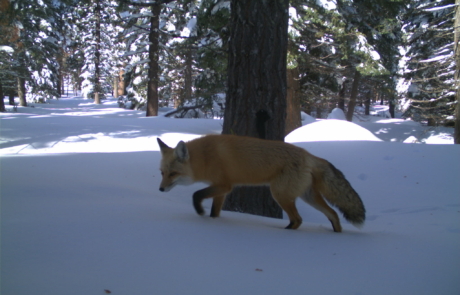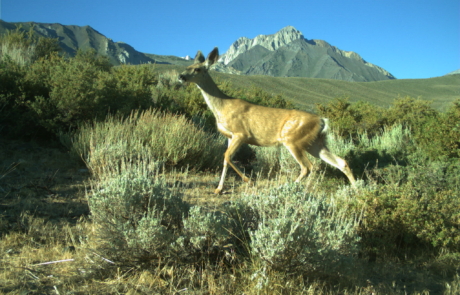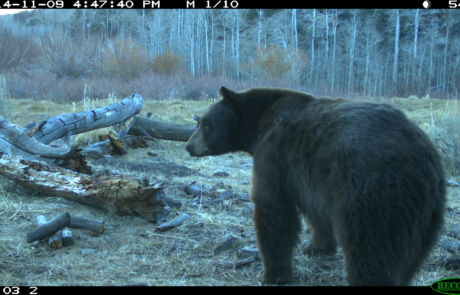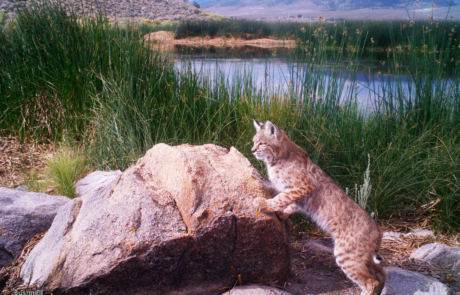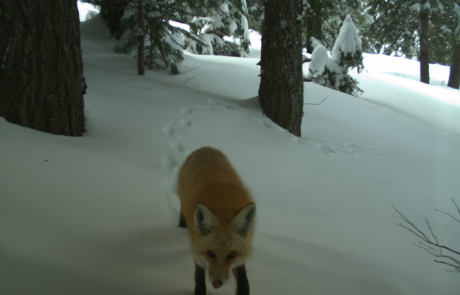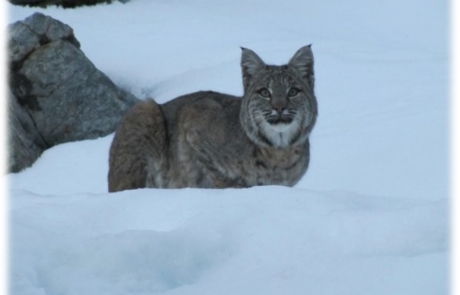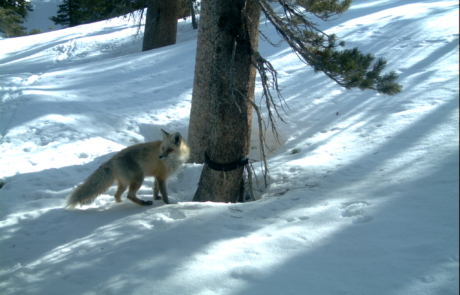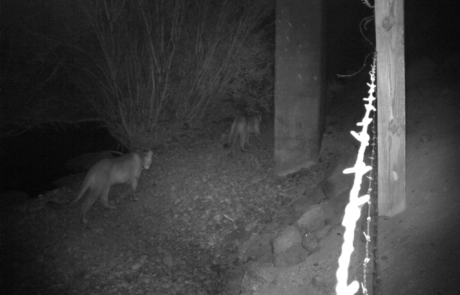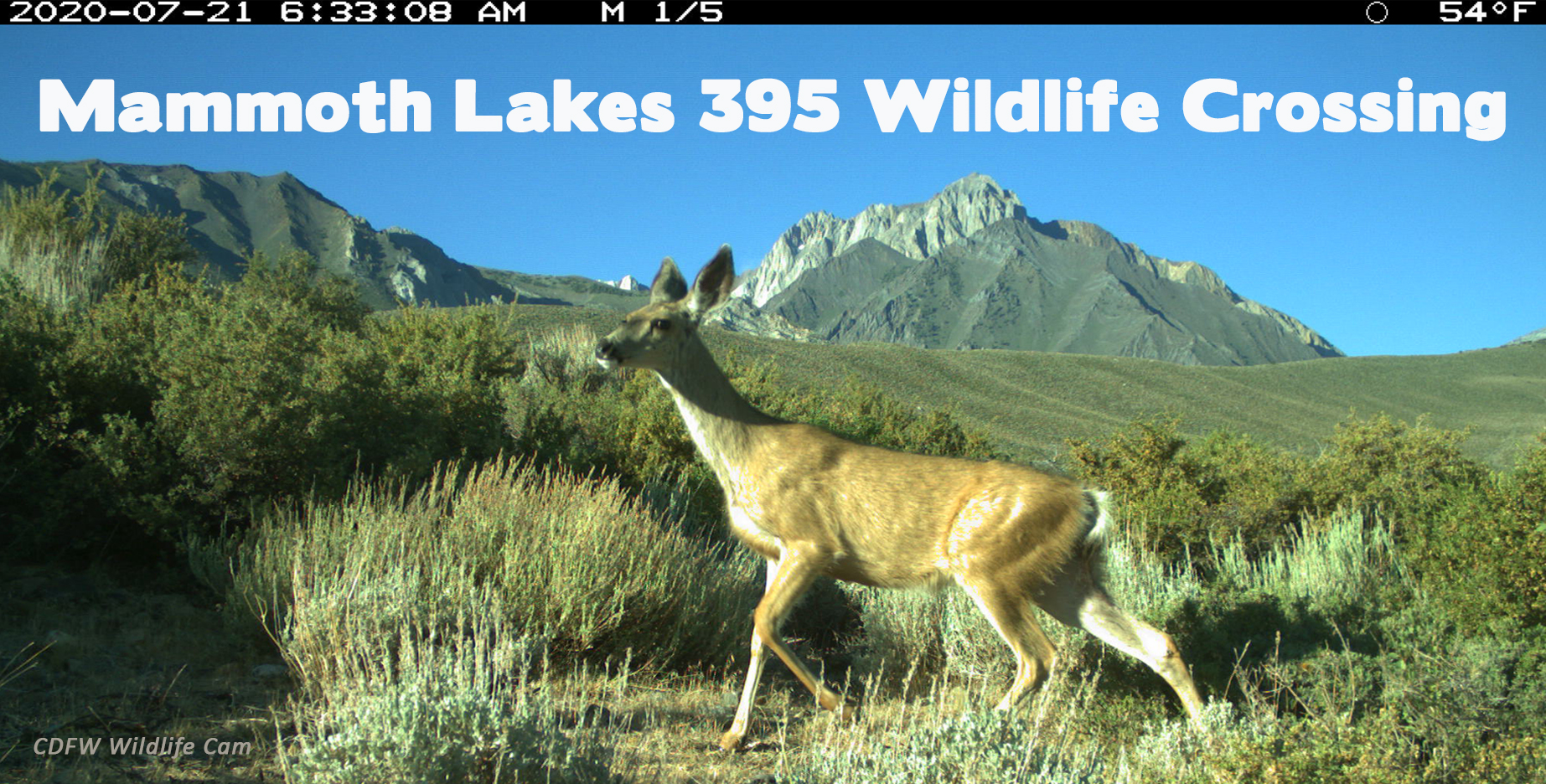
Mule deer captured by wildlife cam after crossing Highway 395 in Mammoth Lakes. They cross the busy road to reach the ranges they’ve migrated to long before the highway existed.
The Mammoth Lakes 395 Wildlife Crossing is a proposed wildlife crossing corridor between the towns of Mammoth Lakes and Crowley Lake consisting of 18 miles of wildlife exclusion fencing, improvements to one existing and three new under crossings, two overcrossings, jump outs, cattle guards, and Intelligent Transportation Systems elements (i.e., flashing beacons).
The Mammoth Lakes 395 Wildlife Crossing will reduce dangerous Wildlife Vehicle Collisions (WVC), increase wildlife connectivity, and enhance access to public lands within this project area.
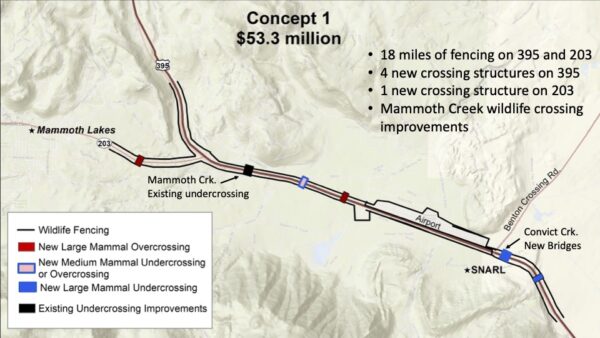
The original idea for a crossing structure along 395 in the Mammoth Lakes 395 Wildlife Crossing Project began in the late 1960s with CDFW and Caltrans Personal installing deer fencing to funnel deer to the existing undercrossing associated with Mammoth Creek, however in 1972 it was determined that those minor installments were mostly ineffective, and the project lost momentum.
The idea for crossing structures was revitalized around 2014- 2015 primarily by the previous Mono County Unit Biologist Tim Taylor and Mono County Supervisor Larry Johnston who brought forth public concerns of deer-vehicle-collisions (DVCs) within the project area. Tim gave several presentations discussing mule deer migration strategies from Round Valley and Casa Diablo herds and how it causes them to interact with the highway to members of the public at SNARL as well as other organizations such as the Eastern Sierra Wildlife Stewardship Team (ESWST) and the Local Transportation Commission (LTC). This eventually prompted the 2016 Caltrans Feasibility Study and provided the momentum for the project that we currently have today.
In 2022 Caltrans applied for and was successful at receiving a Wildlife Conservation Board (WCB) grant for $3.17 million to complete thePA&ED phase (Project Approval and Environmental document). The phase will kick off in March 2023 with field work beginning in Spring 2023.
Caltrans project phases include:
- PID phase (Project Initiation Document)/ K Phase
- PA&ED (Project Approval and Environmental Document)/ 0 Phase
- PS&E (Plans, Specifications and Estimates)/ 1 Phase/ 2 Phase Right-of-Way Acquisition
- RTL (Ready to List)- not a phase but a milestone between PS&E and Construction
- Construction/ 3 Phase
The current phase that was covered by a WCB grant (PA&ED) costs $3.17 million. The remaining phases (PS&E and Construction) are estimated to cost over $65 million to complete. These costs will be evaluated and refined at the end of PA&ED.
The Mammoth Lakes 395 Wildlife Crossing is supported by a collaborative body of partners designed to promote regional collaboration on wildlife crossing issues.
- Bridgeport Indian Colony
- Town of Mammoth Lakes
- USDI Fish and Wildlife Service
- Eastern Sierra Land Trust
- California Department of Fish and Wildlife
- Defenders of Wildlife
- Caltrans District 9
- Mono County
- USDA Forest Service
- USDI Bureau of Land Management
- Los Angeles Department of Water and Power
- Wildlands Network
- Save LA Cougars
- Backcountry Hunters and Anglers
- National Wildlife Federation
Environmental Benefits FAQ
Within Caltrans District 9, the highest frequency of WVCs are documented on Highway 395 and Highway 203 in Mono County between the Community of Crowley Lake and the Town of Mammoth Lakes. Collisions with large mammals, mainly mule deer, come with risk of property damage or even injury to drivers. Furthermore, WVCs can negatively impact deer populations, which are important to the economy, culture, and biology of the region.
Mule deer will benefit the most from this project in terms of collision prevention. Multiple mule deer herds cross Highway 395 twice per year during their annual migrations. They are the mammal species with the largest population in the region as well as the most commonly killed by vehicles. Black bears are a distant second in terms of collision frequency. Collisions with other species are occasionally reported, such as mountain lions, coyotes, gray foxes, and bobcats.
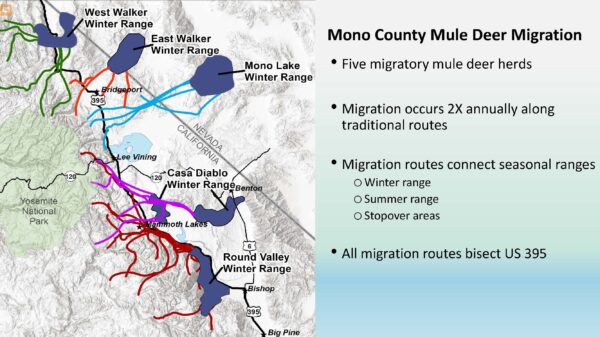
Between 2016 and 2019, there were 226 deer-vehicle collisions reported within the project area along US 395 and SR 203. That is an average of 57 deer-vehicle collisions each year within the project area which is 15 miles long. This area has been identified as the worst wildlife-vehicle collision hot spots within the entirety of the Eastern Sierra Nevada (Mono County, Inyo County, and Eastern Kern County).
Mule deer act as an umbrella species for other large terrestrial mammals that occupy the project area in that they utilize similar terrain features known to cause crossing events with other species. So, by using datasets of GPS-collared mule deer in addition to DVC location data, CDFW has analyzed successful and unsuccessful crossing locations for deer, thereby prioritizing the placement of crossing structures that would most benefit mule deer and other large mammals that utilize similar terrain features to cross the highway (i.e. mountain lions, black bears, bobcats, coyotes).

The proposed project will not only provide connectivity for migrating mule deer but will also enhance existing waterways and riparian habitats utilized by many species. Convict Creek is within the project area and is an important perennial stream that conveys water from Sierra snow melt into the Crowley Lake (HUC 8) watershed in the Long Valley Basin.
The existing Convict Creek culvert is undersized and does not allow for adequate fish passage (non-functioning fish ladder) or riparian vegetation connectivity. By removing the existing culverts and constructing a bridge span, the creek bed and channel will be enhanced, and the riparian vegetation will again be connected under the bridge corridor.
This section of the stream is upstream of habitat further east of the project area for the federally endangered and California state endangered Owens’s tui chub (Siphateles bicolor snyderi). Convict Creek is also habitat for CA Department of Fish and Wildlife Species of Special Concern Owens sucker (Catostomus fumeiventris). Willow flycatcher (Empidonax traillii) which is endangered in California, also have been documented upstream and to the west of the project area in riparian habitats and would also benefit from an enhanced riparian corridor in this location.
Wetland habitats present around Convict Creek will also be enhanced by the project by providing a wider creek bed for seasonal inundation for wetland plants and soils. Wetlands are important habitat for many mammals and nesting bird species and are rare in the Great Basin Desert. This location in the project would restore much of the wetland function in this area to what it was before being inhibited by the construction of the existing US 395.
The project area is also within the South Mono Population Management Unit for Bi-State greater sage-grouse, a California state species of special concern. The wildlife crossing structures may be beneficial for grouse, but more monitoring and study is needed to confirm this.
The project area is also within the Mono Ecoregion of the Deserts Province in the CA Wildlife State Action Plan that identifies Great Basin Pinyon-Juniper woodland and Big Sagebrush Scrub as Conservation Targets. The project area falls within Big Sagebrush habitat. Focal Species of Conservation Strategies within the Big Sagebrush Scrub habitat of the Mono Ecoregion that would benefit from the project would include amphibian species (Northern leopard frog), and multiple bird species (Greater sage grouse, Cooper’s hawk, Northern harrier, several owl species, Prairie falcon, and sparrow species). American badger, mule deer, various bat species, and potentially pronghorn antelope (range expansion over time) would also benefit from this project. The project would improve connectivity for these species, reduce mortality by vehicle collision, and restore wetland and perennial stream habitat along Convict Creek.
As part of this project is within BLM managed lands, it would be consistent with their program for Ecosystem Restoration and Conservation by reconnecting migration and wildlife movement corridors within this area of the Eastern Sierra.
Additionally, there would be improvements in the watershed that would be consistent with the goals of the Sierra Nevada Watershed Improvement Program by removing impediments (undersized culvert structures) from natural creeks within the Sierra Nevada. Convict Creek will be enhanced once this project is constructed, benefiting many fish and wildlife species.
The project area is within the Sierra Nevada Region of the 30×30 strategy and contains a high biodiversity ranking and is adjacent to 30×30 Conservation Areas identified in the plan.
See the Pathways to 30×30 Report for reference.
Seasonal wildlife movement distances increase in years with drought as wildlife must travel further to seek out water sources, vegetation, and prey. The Eastern Sierra has seen increased roadkill and wildlife movement distances in years of drought and wildfire due to this need for animals to travel further. CDFW Biologists have confirmed this trend with animals they are monitoring with GPS collars (mule deer, black bear, mountain lion, bobcat). In drought years with limited snowpack, many deer remain in the project area year-round rather than migrating down to winter ranges located in Round Valley and Benton. All these pressures have forced wildlife to migrate further and cross more roads and highways and enter residential areas creating human-wildlife conflict. This results in more wildlife crossing roads and highways and entering residential areas creating human-wildlife conflict.
As the Mammoth Lakes 395 Wildlife Crossing is within a mule deer migration path, movement of deer specifically is likely to be more frequent here during drought years as they may spend more time in their summer holding area adjacent to our project along US 395. CDFW Biologists have found that water and mesic meadow foraging habitat is available in the project area on both sides of the highway. As a result, GPS collared summer resident mule deer were documented by CDFW to cross US 395 in the project area over 250 times to access food and water resources. As the drought continues, wildlife use of the project is anticipated to increase in response to diminishing mesic resources in outlying areas.
With the implementation of this project, crossing structures will be installed in the two worst roadkill hot spots in the Eastern Sierra to allow safe passage of wildlife under US 395. Without project implementation, this increased wildlife movement during drought will result in additional collisions and wildlife mortality in years where survival is already stressed.
Funding and Donations FAQ
Caltrans has served as the lead for the state funding process (WCB grant). All private gifts made to Eastern Sierra Land Trust through the donation form on this webpage are restricted funds and will only go towards the Mammoth Lakes 395 Wildlife Crossing project.
Currently the project is only funded with state funds (California). Future funding could include federal funding if an opportunity becomes available.
Questions? Contact Us.
Contact us with your questions about the Mammoth Lakes 395 Wildlife Crossing. We will get back to you shortly.
Please utilize the donation form at the bottom of this webpage. All donations are restricted for use solely on the Mammoth Lakes 395 Wildlife Crossing.
November 2022 Wildlife Crossing Grant Update:
In November of 2022, California’s Wildlife Conservation Board (WCB) approved a $3.17 million grant for the Mammoth Lakes 395 Wildlife Crossing Project to fund Caltrans’ PA&ED (Project Approval and Environmental Document) phase of the project. This includes the completion of an environmental document and a Project Report. Once PA&ED is complete, there is still the PS&E (Plans, Specifications, and Estimate) phase to complete that would finalize all the design, obtain permits and agreements, secure any needed Right of Way to acquire, and prepare a package for a contractor to bid on to construct the project.
The PA&ED phase kicks off in March of 2023.
Wildlife of the Eastern Sierra
CDFW wildlife cameras captured images of these animals in the Eastern Sierra. All of these species stand to benefit from the Mammoth Lakes 395 Wildlife Crossing.
Upcoming Events
Past Meetings
395 Wildlife Crossing Project: Beth Pratt and Eastern Sierra Wildlife Stewardship Team
February 11, 2021
Beth Pratt is a world-renowned conservationist. She currently is the Regional Executive Director of the National Wildlife Federation. Among other conservation achievements, Beth led the incredible and successful campaign for the Wallis Annenberg Wildlife Crossing.
In this recorded meeting, Beth Pratt starts with a presentation on her work and wildlife crossing projects in California. Next, the Eastern Sierra Wildlife Stewardship Team discuss the 395 Wildlife Crossing project and fundraising needs for this project to help wildlife safely cross the highway. The presentation is followed by a Q&A segment where audience members have the opportunity to ask questions on the project, or of Beth Pratt and her work.


